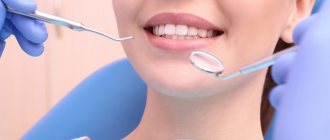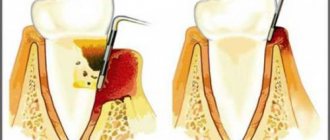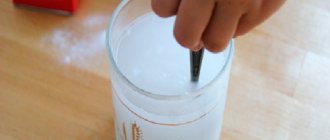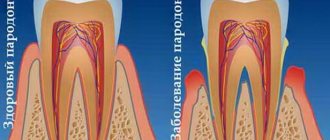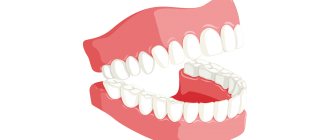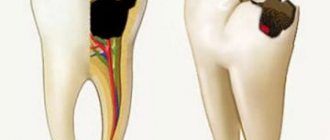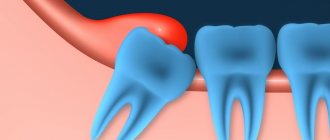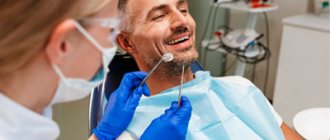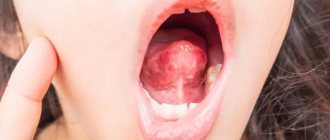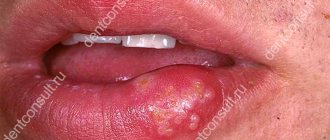November 30, 2020
Periodontal disease is a relatively rare periodontal disease and is characterized by sclerotic changes in bone tissue, leading to exposure of the necks of teeth
Periodontal disease is a relatively rare periodontal disease and is characterized by sclerotic changes in bone tissue, leading to exposure of the necks of teeth. The peculiarity of this disease is its slow development and absence of pain, which often delays the patient’s visit to the dentist.
Periodontal disease is associated with metabolic disorders, so it affects older people more often. According to scientists, if a person himself notices the appearance of the first symptoms of periodontal disease, it means that the disease has been going on for about 15 years and the exacerbation stage has begun. Unfortunately, in most cases, treatment of periodontal disease is characterized by an unfavorable prognosis for the patient: over time, teeth lose stability, become very loose and gradually begin to fall out.
Hydrogen peroxide
Hydrogen peroxide has an excellent anti-inflammatory effect, improves blood supply to tissues and increases oxygen consumption by cells. For the purpose of self-treatment of periodontal disease, peroxide can be taken orally or used externally: rinse the mouth, add to regular toothpaste, or simply rub into the gums.
Dissolve one drop of 3% hydrogen peroxide in 70-100 ml of clean drinking water. The resulting solution should be drunk on an empty stomach. Frequency of application: three times a day. The duration of treatment is usually two courses of 10 days each with a 3-day break in between.
The dosage cannot be increased. It is strictly forbidden to use hydrogen peroxide in its pure form! It must be diluted with water to the specified concentration.
To prepare a mouthwash solution, 2 tablets of dry hydrogen peroxide (hydroperite) are dissolved in 100 ml of boiled cool water. Rinse your mouth thoroughly for a minute. Do not swallow the solution! The procedure should be repeated 3-4 times a day until the signs of periodontal disease completely disappear.
When using toothpaste with an anti-periodontal effect, its effect can be enhanced by 2-3 drops of 3% hydrogen peroxide. It is better to brush your teeth with this mixture using a soft toothbrush with massage inserts.
In advanced cases of periodontal disease, 15-20 drops of hydrogen peroxide are dissolved in 15 ml of water. A sterile gauze swab is moistened in the prepared solution and massaged into the affected gums for several minutes twice a day. Courses of treatment last 30 days.
Gel
A good effect in treating periodontal disease at home is provided by the use of gels that increase blood supply to the gums, have an anti-inflammatory effect, and also have a pronounced trophic effect.
Troxevasin
Troxevasin gel has an anti-periodontal effect by strengthening the vascular wall in the capillaries of the gums, improving blood supply to tissues, and enhancing metabolic processes in cells.
Using gentle massage movements, rub the gel into the gums until it is completely absorbed. The procedure should be repeated twice a day after regular hygienic brushing of teeth. The course of treatment is 30 days.
Biodent gel
The gel contains calcium hydroxyapatite, a substance that helps restore tooth tissue and also prevents the deposition of hard plaque. Biodent gel also contains chlorhexidine, a powerful antiseptic that eliminates inflammation in the periodontium. The action of the active components of the gel is complemented by calamus root extract, which improves the trophism of the tissues around the tooth and restores impaired blood circulation.
Biodent gel is recommended to be used twice a day after meals and mechanical brushing of teeth. The drug is applied to the teeth and gums with massaging movements using a toothbrush with soft bristles for 5-7 minutes. There is no need to rinse your mouth after the procedure. You should also refrain from eating, drinking and smoking for 30 minutes. Courses of treatment lasting 2-3 weeks are carried out regularly, with breaks between them of 3-4 weeks.
Elugel
The active ingredient of the drug is chlorhexidine. It has an antimicrobial effect, relieves inflammation of the gums and tissues surrounding the tooth.
The gel is applied in a thin layer to the affected gums 3-4 times a day. The duration of therapy depends on the severity of periodontal disease and averages 2 weeks.
Elgifluor
Elgifluor teeth cleaning gel contains fluorinol and chlorhexidine digluconate, which have a bacteriostatic effect, prevent the deposition of tartar and suppress inflammation in the tissues surrounding the teeth.
Elgifluor is applied to a toothbrush and cleanses the surface of the teeth and gums for 3-4 minutes. Repeat the procedure 3 times a day until the signs of the disease completely disappear.
Holisal
Cholisal gel has a powerful anti-inflammatory effect. improves nutrition of periodontal tissues, has an antibacterial effect.
To treat periodontal disease, the gel is injected into the gum pockets or rubbed into the gums twice a day. For adults, 1 cm of the drug is enough. The duration of treatment is individual and depends on the speed of disappearance of the clinical manifestations of the disease.
Symptoms of periodontal disease
The disease manifests itself in the gradual receding of the gums, the necks and roots of the teeth are exposed, which may cause an increase in their sensitivity to temperature influences. The development of periodontal disease takes several years.
There may be no other complaints other than tooth sensitivity in response to temperature and food irritants. In some cases, tooth mobility is observed - usually in the later stages of the disease, when the edge of the gum is significantly lowered. But in general, the disease causes virtually no discomfort, and therefore is often discovered only during a routine examination by the dentist.
The extent of symptoms depends on the stage of the disease. In general, the obvious signs of periodontal disease are: exposure of the neck of the tooth and roots; pale gums; increased sensitivity of teeth to cold, hot, salty; defects in tooth enamel and changes in its color; sclerosis of bone tissue (especially noticeable on x-rays); visual increase in interdental spaces; itching in the gum area; loosening of teeth.
At the first stage of the disease, the patient complains of slight sensitivity of the teeth, which manifests itself with temperature changes. X-rays show initial signs of bone atrophy. The moderate to severe degree is characterized by the onset of gum recession and exposure of the roots of the teeth, the interdental spaces increase. The image already shows the destruction of bone tissue along more than a third of the length of the tooth root. At the last, severe stage, the exposure of bone tissue reaches 4–5 mm; due to hypotrophy of the gingival papillae, there is a pronounced increase in interdental spaces; due to their discrepancy, the bite changes, functional activity decreases, swelling of the gums and tooth mobility increases. It is important to answer that periodontal disease is not characterized by bleeding gums or inflammatory processes, although at a later stage these symptoms are not excluded.
Ointment
Ointments have become widespread in the fight against periodontal disease. They can improve blood flow in the gums, have a healing effect and help preserve teeth.
Heparin ointment
It has the property of thinning the blood at the site of application, thereby improving microcirculation in blood vessels and metabolism in tissues. A small amount of ointment is rubbed into the affected gums twice a day. The course of treatment is 14 days.
Solcoseryl
Solcoseryl ointment has a powerful restorative effect, improves the absorption of oxygen and glucose by tissues. For periodontal disease, the drug is applied to the gums with massage movements for 2-3 minutes. Therapy is carried out until symptoms disappear completely.
Levomekol
Levomekol contains antibacterial and wound-healing components that promote faster restoration of periodontal tissues and eliminate symptoms of inflammation. Levomekol is used as an ointment for gums against periodontal disease in advanced cases. It is applied as an application on a sterile gauze pad to the affected area twice a day. The duration of use depends on the clinical manifestations and continues until the condition improves.
Antibiotics and antiseptics
Pathogenic microorganisms are not the main cause of periodontal disease, but their vital activity indirectly contributes to its development - it is no coincidence that a significant proportion of patients suffering from this disease exhibit one or another degree of decreased immunity. Accumulating in enlarged periodontal pockets and interdental spaces, the bacterial mass can cause inflammation, which in normal cases is not characteristic of this disease. That is why, in case of periodontal disease, it is often recommended to use various agents that can destroy pathogenic microflora and reduce the risk of secondary infection.
In the most severe cases, antibiotics in the form of capsules or tablets are used for this purpose, such as doxycycline and metronidazole, trichopolum, lincomycin. Broad-spectrum antibiotics effectively suppress the activity of microflora and contribute to the rapid elimination of inflammatory and infectious manifestations that complicate the course of the disease. However, long-term use of antibiotics is undesirable due to side effects and suppressive effects on the natural microflora of the body. They can only be used as prescribed by a doctor.
For a more gentle disinfecting effect, it is recommended to use rinses, gels, sprays and other external products containing antiseptics. In particular, the antibacterial rinse ASEPTA, which contains benzydamine and chlorhexidine. The adhesive balm ASEPTA, which contains metronidazole and chlorhexidine, thanks to its sticky base, is retained on the gums for a long time and has a long-term healing effect. Extracts of sage, witch hazel, chamomile, as well as xylitol, which are part of the ASEPTA Fresh mouthwash, also have a mild antiseptic and anti-inflammatory effect.
Toothpastes
You can also cure periodontal disease at home using special toothpastes with an anti-periodontal effect. Unlike conventional dental hygiene products, medicinal pastes contain antimicrobial components, minerals and plant extracts. They have a beneficial effect on the condition of the gums, improve blood microcirculation, relieve inflammation, and stimulate periodontal renewal.
Medicinal toothpastes for the treatment of diseases:
- LACALUT Active
- PRESIDent Active
- Splat Green tea
- Parodontax
- Forest balm
- Parodontol Active
You should use medicated toothpastes only after consulting your dentist. They are used to brush your teeth twice a day for 3 minutes using massage toothbrushes. Courses of treatment last 30-60 days with breaks between them of 2-3 months.
Salt treatment
One of the most effective and proven means for the treatment of periodontal disease is salt. It stimulates restoration processes in periodontal tissues, relieves inflammation and prevents the formation of tartar on the surface of the enamel.
When treating, it is better to use sea salt, which is rich in iodine compounds and fights the disease even more effectively.
To prepare the solution, dissolve 1-2 teaspoons of salt in a glass of warm boiled water and rinse your mouth for 2-3 minutes. The procedure should be repeated after each meal at least 3 times a day.
Salt massage has proven itself well. Lightly moisten a soft toothbrush with water and then dip the ends of the bristles in fine salt. Then massage the gums and teeth for 3-4 minutes, paying special attention to areas with periodontal disease. There is no need to rinse your mouth after the procedure. The massage must be repeated once a day before bedtime.
When used regularly, sea salt is a reliable remedy for preventing disease at home.
Causes
The causes of periodontal disease are not yet fully understood. Most likely, there is a whole complex of factors contributing to the occurrence of the disease.
First of all, the cause may be a hereditary predisposition to periodontal disease. According to current research on this disease, there are several factors that, regardless of each other, can trigger the development of the disease. These include: hereditary predisposition; malocclusion; bruxism; age-related disorders of gingival circulation, tooth wear; hypovitaminosis A, C and P; insufficient oral hygiene; complications of dental treatment that caused tissue damage; negative impact of physical and chemical factors; tartar; somatic diseases (atherosclerosis, diabetes mellitus, hypertension, etc.); chewing overloads remaining after tooth extraction. It is noteworthy that tartar, which often forms during periodontal disease, is more a consequence than a cause of the disease.
